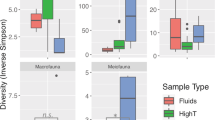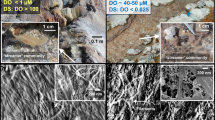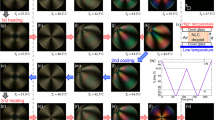Abstract
A novel hydrothermal site was discovered in March 2007, on the mid-Atlantic ridge during the cruise ‘Serpentine’. At a depth of 4100 m, the site ‘Ashadze’ is the deepest vent field known so far. Smoker samples were collected with the ROV ‘Victor 6000’ and processed in the laboratory for the enrichment of anaerobic heterotrophic microorganisms under high-temperature and high-hydrostatic pressure conditions. Strain CH1 was successfully isolated and assigned to the genus Pyrococcus, within the Euryarchaeota lineage within the Archaea domain. This organism grows within a temperature range of 80 to 108 °C and a pressure range of 20 to 120 MPa, with optima for 98 °C and 52 MPa respectively. Pyrococcus CH1 represents the first obligate piezophilic hyperthermophilic microorganism known so far. Comparisons of growth yields obtained under high-temperature/high-pressure conditions for relative organisms isolated from various depths, showed clear relationships between depth at origin and responses to hydrostatic pressure.
Similar content being viewed by others
Log in or create a free account to read this content
Gain free access to this article, as well as selected content from this journal and more on nature.com
or
References
Alain K, Marteinsson VT, Miroshnichenko ML, Bonch-Osmolovskaya EA, Prieur D, Birrien JL . (2002). Marinitoga piezophila sp. nov., a rod-shaped, thermo-piezophilic bacterium isolated under high hydrostatic pressure from a deep-sea hydrothermal vent. Int J Syst Evol Microbiol 52: 1331–1339.
Balch WE, Wolfe RS . (1976). New approach to the cultivation of methanogenic bacteria: 2-mercaptoethanesulfonic acid (HS-CoM)-dependent growth of Methanobacterium ruminantium in a pressurized atmosphere. Appl Environ Microbiol 32: 781–791.
Barbier G, Godfroy A, Meunier JR, Quérellou J, Cambon MA, Lesongeur F et al. (1999). Pyrococcus glycovorans sp. nov., a hyperthermophilic archaeon isolated from the East Pacific Rise. Int J Syst Bacteriol 49: 1829–1837.
Bartlett DH . (2002). Pressure effects on in vivo microbial processes. Biochim Biohys Acta 1595: 367–381.
Cambon-Bonavita MA, Lesongeur F, Pignet P, Wery N, Lambert CRR, Godfroy A et al. (2003). Thermococcus atlanticus sp. nov., a hyperthermophilic Archaeon isolated from a deep-sea hydrothermal vent in the Mid-Atlantic Ridge [corrected]. Extremophiles 7: 101–109. Erratum in: Extremophiles 2003; 7: 339.
Charlou JL, Donval JP, Konn C, Birot D, Sudarikov S, Jean Baptiste P et al. (2007). High hydrogen and abiotic hydrocarbons from new ultramafic hydrothermal sites between 12°N and 15°N on the Mid Atlantic Ridge. Results of the Serpentine cruise (March 2007). AGU Fall Meeting, EOS 88: 52.
DeLong EF . (1992). Archaea in coastal marine environments. Proc Natl Acad Sci USA 89: 5685–5689.
Erauso G, Reysenbach AL, Godfroy A, Meunier J, Crump B, Partensky F et al. (1993). Pyrococcus abyssi sp. nov., a new hyperthermophilic archaeon isolated from a deep-sea hydrothermal vent. Arch Microbiol 160: 338–349.
Fiala G, Stetter KO . (1986). Pyrococcus furiosus sp. nov. represents a novel genus of marine heterotrophic archaebacteria growing optimally at 100 °C. Arch Microbiol 145: 56–61.
Fouquet Y, Cherkashov G, Charlou JL, Ondréas H, Cannat M, Bortnikov N et al. (2007). Diversity of ultramafic hosted hydrothermal deposits on the Mid Atlantic Ridge: first submersible studies on Ashadze, Logatchev 2 and Krasnov vent fields during the Serpentine cruise. AGU Fall Meeting, EOS 88: 52.
González JM, Masuchi Y, Robb FT, Ammerman JW, Maeder DL, Yanagibayashi M et al. (1998). Pyrococcus horikoshii sp. nov., a hyperthermophilic archaeon isolated from a hydrothermal vent at the Okinawa Trough. Extremophiles 2: 123–130.
Marteinsson VT, Moulin P, Birrien JL, Gambacorta A, Vernet M, Prieur D . (1997). Physiological Responses to Stress Conditions and Barophilic Behavior of the Hyperthermophilic Vent Archaeon Pyrococcus abyssi. Appl Environ Microbiol 63: 1230–1236.
Marteinsson VT, Birrien JL, Reysenbach AL, Venet M, Marie D, Gambacorta A et al. (1999). Thermococcus barophilus sp. nov., a new barophilic and hyperthermophilic archaeon isolated under high hydrostatic pressure from a deep-sea hydrothermal vent. Int J Syst Bacteriol 49: 351–359.
Stackebrandt E, Goebel BM . (1994). Taxonomic note: a place for DNA-DNA reassociation and 16S rRNA sequence analysis in the present species definition in bacteriology. Int J Syst Bacteriol 44: 846–849.
Stackebrandt E, Frederiksen W, Garrity GM, Grimont PAD, Kampfer P, Maiden MCJ et al. (2002). Report of the ad hoc committee for the re-evaluation of the species definition in bacteriology. Int J Syst Bacteriol 52: 1043–1047.
Takai K, Sugai AT, Itoh T, Horikoshi K . (2000). Palaeococcus ferrophilus gen. nov., sp. nov., a barophilic, hyperthermophilic archaeon from a deep-sea hydrothermal vent chimney. Int J Syst Evol Microbiol 50: 489–500.
Acknowledgements
We thank the captain and crew of the research vessel Pourquoi Pas? and the Victor 6000 team. This work was supported by the CNRS, the MESR and the IFREMER. This study was also supported by the National Natural Science Foundation of China (NSFC, Grant No. 40625016), China Ocean Mineral Resources R&D Association (COMRA DYXM-115–02–2–01). X. Zeng has received a fellowship from China Scholarship Council.
Author information
Authors and Affiliations
Corresponding authors
Rights and permissions
About this article
Cite this article
Zeng, X., Birrien, JL., Fouquet, Y. et al. Pyrococcus CH1, an obligate piezophilic hyperthermophile: extending the upper pressure-temperature limits for life. ISME J 3, 873–876 (2009). https://doi.org/10.1038/ismej.2009.21
Received:
Revised:
Accepted:
Published:
Issue date:
DOI: https://doi.org/10.1038/ismej.2009.21
Keywords
This article is cited by
-
Identification of a deep-branching thermophilic clade sheds light on early bacterial evolution
Nature Communications (2023)
-
Microorganisms from deep-sea hydrothermal vents
Marine Life Science & Technology (2021)
-
Transcriptomic Analysis Reveals Common Adaptation Mechanisms Under Different Stresses for Moderately Piezophilic Bacteria
Microbial Ecology (2021)
-
Role of extremophiles and their extremozymes in biorefinery process of lignocellulose degradation
Extremophiles (2021)
-
Synthesizing Chiral Drug Intermediates by Biocatalysis
Applied Biochemistry and Biotechnology (2020)



